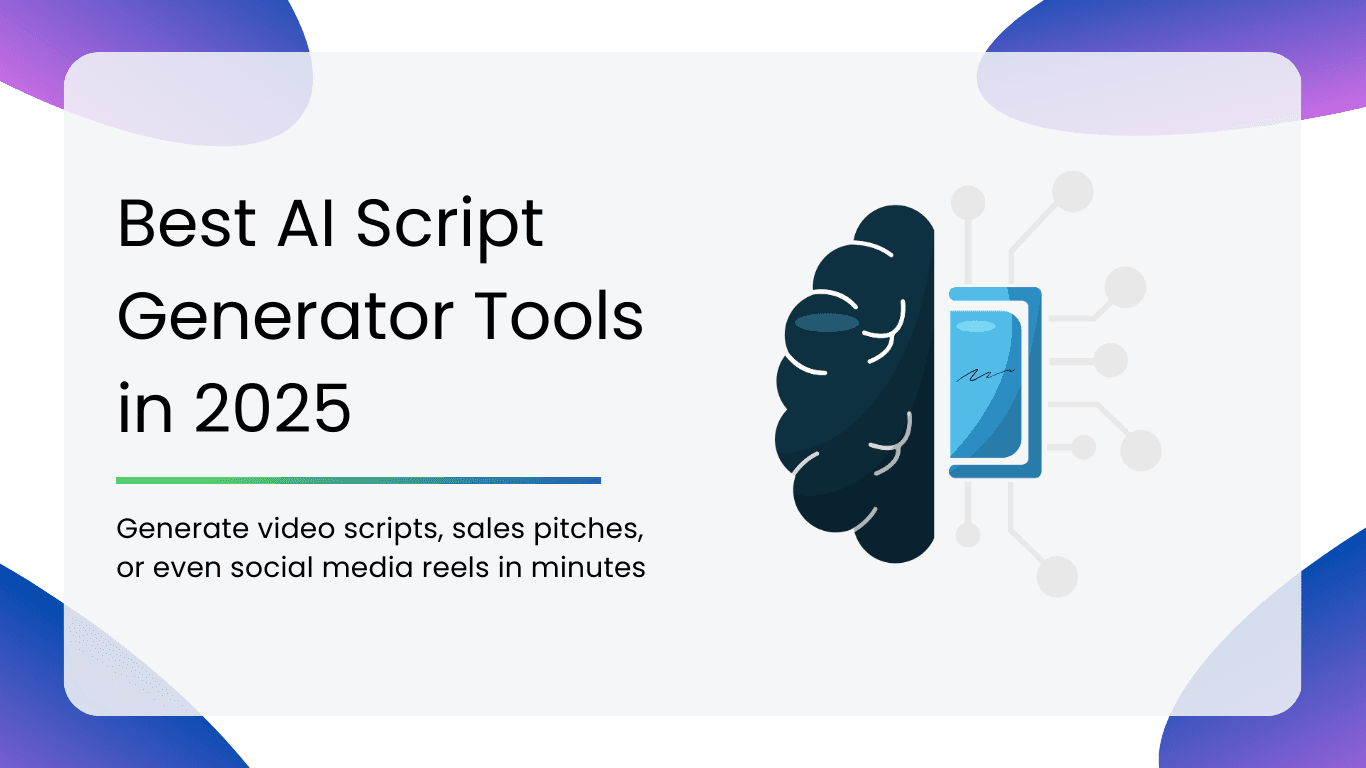In 2025, AI tools have become smarter, faster, and more accessible than ever before. With just a few prompts, you can generate engaging video scripts, sales pitches, or even social media reels in minutes. Not only do they save time, but they also help spark fresh ideas you might not have thought of on your own.
But with so many options out there, which tools are actually worth your time? Don’t worry, we’ve done the research. In this article, we’ll break down the best AI script generator tools in 2025 and show you how they can supercharge your content creation process.
How to Choose the Best AI Script Generator
Not all AI script generators are created equal. While most can churn out text, the best ones go beyond simple word-spitting and actually help you create polished, production-ready scripts. Here are the key features you should look for in 2025:
- Customizability: The best tools let you adjust tone, style, and complexity. Whether you want a casual script for TikTok, a persuasive pitch for clients, or a cinematic voiceover for YouTube, customization ensures the content matches your brand voice.
- Addition of Elements: Great script generators don’t just stop at dialogue. Look for tools that let you add plot points, characters, or fresh ideas mid-script. This gives you flexibility to refine the story as it unfolds.
- Scene Descriptions: Storytelling lives in the details. Advanced tools can create vivid scene descriptions that help you bring your content to life, perfect for short films, explainer videos, or ad campaigns.
- Collaboration Features: Content creation is rarely a one-person show. Top-tier platforms allow team sharing, real-time co-editing, and smooth collaboration, so your entire crew stays aligned.
- Image Generation: Many tools now pair scripts with AI-generated visuals. This feature helps you storyboard your ideas, visualize characters, or even create thumbnails for videos, all in one platform.
- Content Quality Control: Not every draft will be perfect, but the best tools include built-in editing, reviewing, and refining options to keep scripts polished and production-ready.
- Price & Subscription Plans: Finally, consider your budget. Some tools offer free tiers, but for consistent, high-quality output, subscription plans often give you better customization, speed, and support.
Comparison of Best AI Script Generator Tools in 2025
| Tool Name | Best For | Key Highlights | Not Ideal For |
| Writesonic | Marketing Content Creators | Rich templates, SEO tools, image integration | Needs polishing for complex narratives |
| ChatGPT | Ideation and long-form scripting | GPT-5 prompts, tone controls, research tools | Requires guidance and structure |
| Copy.ai | Short-form marketing copy | Brand voice, workflows, speed | Weak on long-form storytelling |
| Jasper | Branded enterprise content | Voice cloning, templates, agentic workflows | Pricey, steeper learning curve |
| Rytr | Budget content creators | Fast, multilingual, straightforward interface | Poor at deep narratives |
| Squibler | Screenwriters and authors | Narrative structure, progress tools, visual planning | Less fit for bite-sized scripts |
| Synthesia | Avatar-led video scripting | Avatars, multilingual voiceovers | Not cinematic storytelling |
| Simplified | All-in-one content creation | Script-to-video, design tools, team collaboration | Overwhelming feature set |
Best AI Script Generator Tools in 2025
| Table of Contents |
| 1. Writesonic |
| 2. ChatGPT |
| 3. Copy.ai |
| 4. Jasper |
| 5. Rytr |
| 6. Squibler |
| 7. Synthesia |
| 8. Simplified |
1. Writesonic
Writesonic has become a go-to AI sidekick for content creators in 2025, especially those who need to crank out everything from social media copy to long-term articles, and yes, even scripts. Its wide-ranging toolkit and intuitive interface make it a versatile pick whether you’re crafting ad dialogue, podcast track talks, or video storytelling.
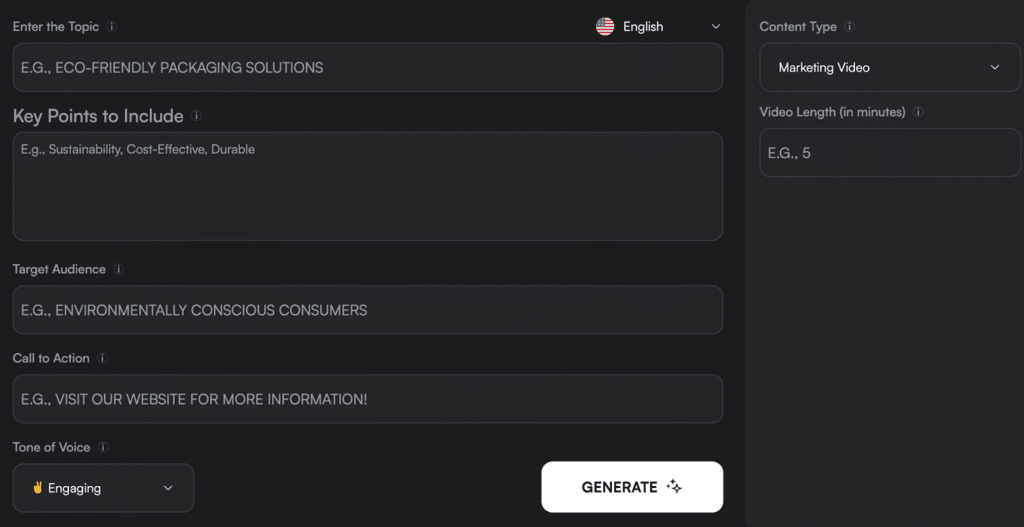
Key Features:
- Huge Templates Library & Flexible Writing Styles: Over 80 content types, from blog posts to ad copy to video outlines, backed by tone-change tools to shift your voice from witty to serious in a few clicks.
- SEO+Content Strategy Built Right In: Powerful SEO integrations (SurferSEO, Ahrefs, Google Keyword Planner) and AI agents help craft not only what you write, but how to get it seen.
- Image Generation Included: It lets you whip up visuals for storyboards or characters, handy when you’re sketching a script’s visual vibe.
- Smart Editing Tools: Built-in tone changer and passive-to-active voice tools help tighten dialogue, ensuring your script sounds like you, not an AI clone.
- Collaboration-Ready: Supports real-time edits, feedback loops, file exports (Word, PDF), and integrations like Zapier and WordPress.
Cons:
- Learning Curve: There’s so much under the hood that initial overwhelm is real. Some advanced tools take time to master.
- Pricing Gets Steep: Free plans are generous, but to unlock GPT-4, extended word counts, and advanced features, you’ll need to upgrade.
Review: Writesonic stands out as a powerful, all-in-one creative studio in an AI platform. It may not market itself as a “script generator,” but with its mix of tone flexibility, structure templates, SEO insights, and even visual aids, you can absolutely use it to craft tight, engaging scripts.
2. ChatGPT
ChatGPT continues to be one of the most versatile AI assistants out there, and in 2025, it’s even stronger. Thanks to the powerful GPT-5 upgrade, it’s not just about generating text anymore. Whether you need dialogue, scene ideas, or a full script outline, ChatGPT is ready to brainstorm, structure, and polish your storytelling.
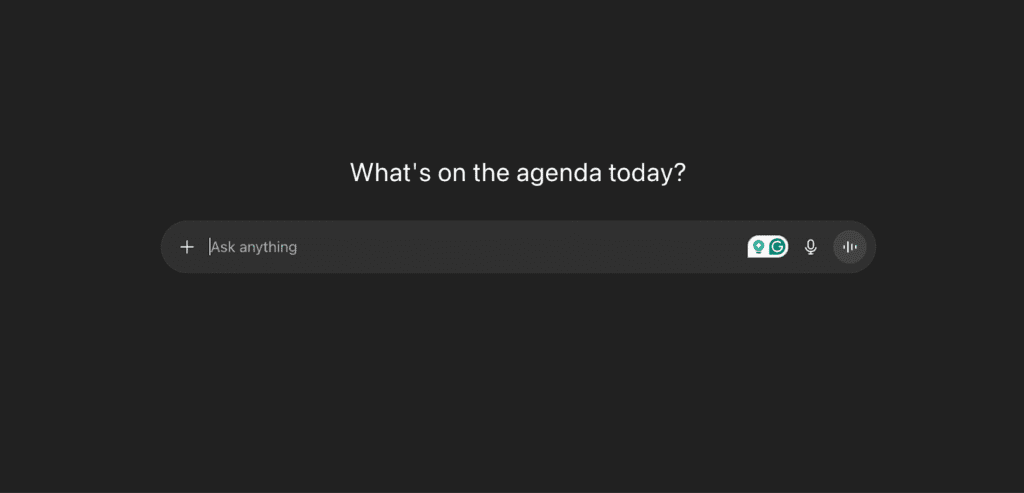
Key Features:
- Top-Tier Text Generation: GPT-5 delivers highly coherent text and can maintain narrative flow across very long prompts, like multi-page scenes or character arcs.
- Adaptive Tone Control: You can dial in the tone to match your creative vision via personality presets and tone adjustments.
- Deep Research Agent: ChatGPT’s integrated “Deep Research” tool can autonomously pull in context and background details for your script by browsing the web.
- Multimodal Input Support: With GPT-4o capabilities still in play, ChatGPT can now process voice, images, or text prompts, so you can feed in a rough storyboard or image mockup to direct your script’s tone or visual cues.
- Agentic Capabilities: ChatGPT agents like Operator and Codex can automate tasks such as filling forms or generating and debugging code.
Cons:
- Hallucinations Still Happen: Even with stronger models, it may invest facts, scene details, or references, so any background or research-based info still needs a human check.
- Over-Reliance Risks Diluted Voice: If you lean too heavily on AI output without refining or personalizing it, your script can start to sound generic or AI.
Review: ChatGPT in 2025 is like having a full-fledged scriptwriting studio right in your browser. Its ability to think in paragraphs, adjust mood, fetch context, and handle mixed-media inputs means you can ideate, draft, and refine in one streamlined flow. That said, it’s still a co-writer; you’ll need to guide it, tweak the tone, and vet for accuracy.
3. Copy.ai
If you’re looking for an AI tool that jumps straight into “just-start-writing” mode with minimal friction, Copy.ai is like your creative space in 2025. It’s not just a prompt-and-go generator; it’s a full-on GTM (Go-to-Market) AI platform, packed with workflows, brand voice alignment, and marketing-friendly templates that get your script.
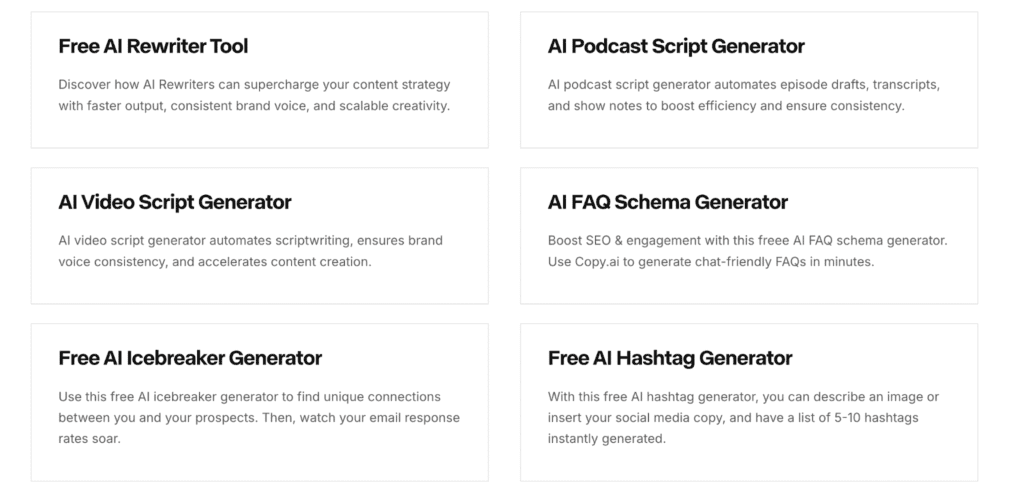
Key Features:
- Ocean of Templates: With 90-plus content tools, it’s like having a writing wizard. Plus, workflows let you automate entire sequences: brainstorming, drafting, editing, etc.
- Brand Voice & Infobase: Copy.ai lets you train a brand-specific voice by feeding it sample text, so outputs feel more like you.
- Super Easy UI for Marketers: The interface is intuitive and distraction-free, ideal for jumping straight into content creation without clicking around endlessly.
- Multi-Lingual Support: Supports almost 100 languages and offers features like a Prospecting Cockpit and CRM integration to fuel personalized outreach.
- Free-Tier Available: You can get started with a robust free plan before scaling up.
Cons:
- Less Ideal for Deep Scripts: Long-form, nuanced storytelling can feel a bit shallow, great for outlines, but not complex scripts.
- Quality & Depth Can Vary: Outputs might be loose, generic, or even repetitive if your prompts aren’t sharp, and they may need fact-checking or rewriting.
Review: Copy.ai’s brand voice feature is a standout, making outputs feel on-point, and the GMT-focused workflows give it a strategic edge beyond writing. That said, if your script demands emotional complexity, layered storytelling, or cinematic pacing, you might end up tweaking it heavily.
4. Jasper
In 2025, Jasper is one of the few tools that brings script-writing, storytelling, SEO, and brand strategy under one roof. It is more like an AI studio: from YouTube scripts to dialogue-driven ads, Jasper has got your back.

Key Features:
- Dedicated Script Templates & YouTube Support: Jasper offers specialized formats like YouTube script generators with built-in structures, so you’re never starting from scratch.
- Multilingual & Brand Voice Capabilities: Create in over 30 languages and align writing with your brand’s signature tone using customizable brand voice tools.
- Agentic Workspace & Workflow Tools: Its Canvas and AI Studio let you map, plan, and build agent-driven content workflows, ideal for complex projects or collaborative teams.
- Clipdrop Integration for Visuals: With Jasper’s acquisition of Clipdrop, you can now generate or edit images alongside your script.
- Robust Template Library: Over 50+ templates across content types, plus “Boss Mode” for command-driven, high-speed writing.
Cons:
- Steeper Learning Curve: With so many templates, modes, and integrations, Jasper can feel overwhelming at first.
- Sometimes Repetitive or Generic Outputs: Jasper can produce slick scripts, but complex storytelling or deep nuance might still need manual revision.
Review: If you’re producing diverse content, it’s a powerhouse. It is like a strategic companion that rewards intentional use. Train your brand voice, explore agentic workflows, and Jasper can help you bring rich, polished scripts to life faster than ever.
5. Rytr
Rytr is the AI writing assistant that you go to when you need ideas, outlines, or punchy copy in a click. In 2025, it’s still the top pick of marketers, freelancers, and content creators looking for high-quality output without breaking the bank.
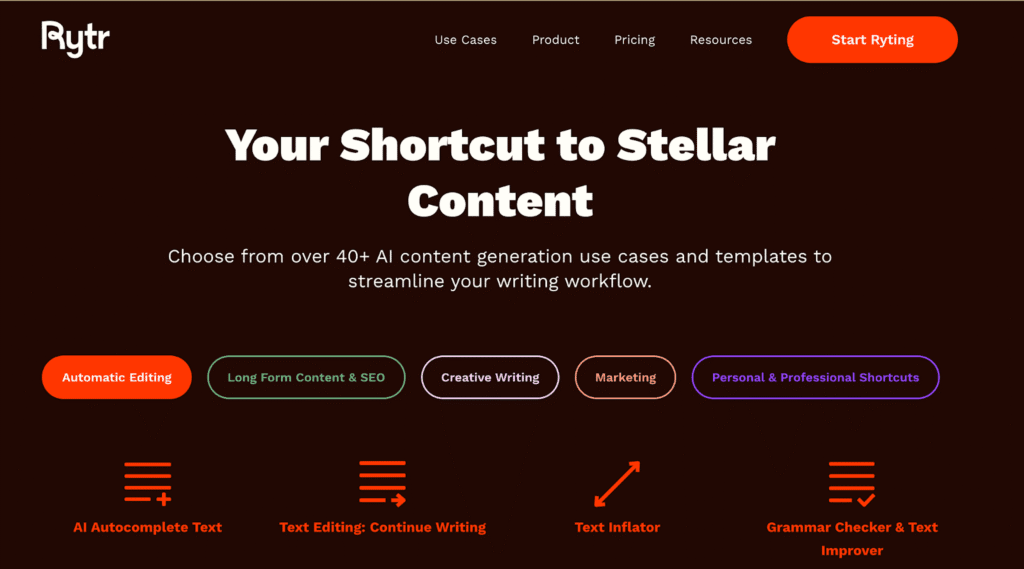
Key Features:
- 40+ Use Cases: Whether you’re sketching a video description, blog outline, product description, or even a poem, Rytr’s got you covered.
- Tone & Creativity Customization: Pick from 20+ tones and tweak creativity levels to suit your mood or project.
- Built-In Editor: Rytr’s rich text editor isn’t for corrections. It also checks your grammar, detects plagiarism, and offers SERP analysis and keyword suggestions.
- AI Writing Profiles: It lets freelance writers build public profiles and portfolios right on the platform.
- Pricing That’s Hard to Beat: Starting with a free tier offering 10K characters/month, Rytr’s paid plans range from Unlimited to Premium with perks like more languages, tone options, plagiarism checks, and even a dedicated account manager.
Cons:
- Not Built for Long-Form Depth: Rytr tends to repeat itself and struggles with complex narrative structure.
- Basic UX & Feature Depth: The interface is clean, but perhaps too simple if you’re used to powerful features.
Review: If you need the AI to do the heavy storytelling, Rytr isn’t there yet. But if you want a tool that frees up your creative momentum and gives you a solid first draft or outline, it’s a powerful ally.
6. Squibler
Geared towards novelists, screenwriters, and storytellers of all stripes, it blends narrative structure, AI-generated content, and project management into one seamless, creative engine. Squibler is designed just for you and helps bring your vision to life.
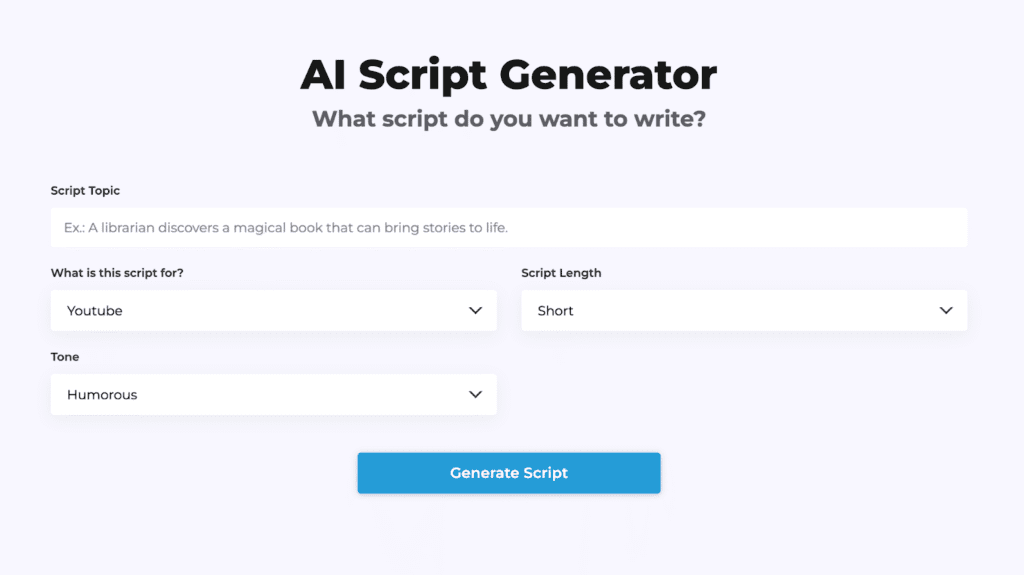
Key Features:
- True-to-Form AI Script Generator: Start with a simple prompt, and Squibler can craft entire scripts, scenes, or screenplay outlines in minutes.
- Element-Based Scene Building: Squibler lets you drop narrative building blocks in place and watch the script unfold around them.
- Project Organization & Progress Tracking: Timelines, storyboards, chapter/scene list views, word-count goals, and visual progress bars help you stay on track and keep creative momentum alive.
- Visual & Print-Ready Extras: Squibler includes image generation, customizable book cover designs, and even an option to get a printed copy.
- Cloud-Based Real-Time Collaboration: Whether you’re co-writing with another creator or sharing drafts with your team, Squibler’s cloud interface supports real-time editing and seamless team workflows.
Cons:
- Can Feel Overwhelming at First: With its deep feature set, some users find it takes time to learn all the ins and outs.
- Performance Can Lag: Bigger scripts or books sometimes slow the platform down.
Review: Squibler carves out a powerful niche as an all-in-one AI script and story assistant. Its element-driven generation, narrative organization, and collaboration features make it perfect for writers who want structure and creativity to move in sync.
7. Synthesia
This AI-driven powerhouse lets you generate polished, avatar-led videos from simple text to uploaded documents. Synthesia transforms your words into persuasive, multilingual videos in minutes.
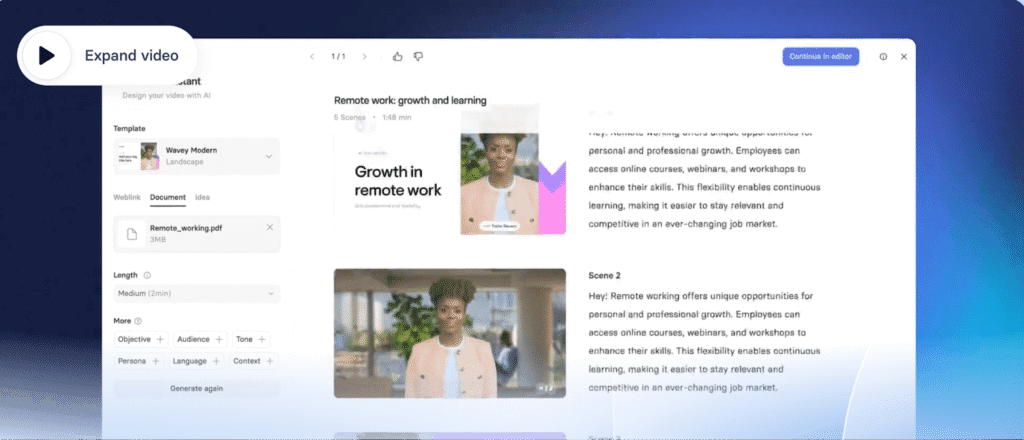
Key Features:
- Instant AI-to-Video: Type a prompt or script, pick a template, and Synthesia generates both the script and a full video sequence.
- 230+ Avatars: Choose from a vast avatar library, including custom ones.
- Real-Time Collaboration: Teams can co-edit, comment, and manage versions live.
- Enterprise-Grade Templates: With 250+ professionally designed templates and brand-kit tools, it’s perfect for training, onboarding, marketing, or internal communications.
- Security & Global Trust: Synthesia is trusted by 60% of Fortune 100 Companies, is SOC Type II and GDPR compliant, and upholds ethical safeguards.
Cons:
- Uncanny Valley Risks: While avatars look impressively realistic, some audiences might still find them a bit off-putting in tone.
- Less Cinematic, More Corporate: Synthesia shines for training and presentations, but it’s not built for creative storytelling or cinematic tools.
Reviews: If you’re aiming for emotional depth or cinematic flair, this tool is more about clarity and efficiency than artistry. Use it professionally, multilingually, script-to-screen ready, and let your creative layers shine around it.
8. Simplified
If you’re juggling scripts, social media posts, videos, and visuals, Simplified is like your entire creative studio, right in your browser. Simplified stands out as an all-in-one AI platform that lets you generate scripts for TikTok, YouTube, or podcasts, design graphics, edit videos, and manage content workflows.
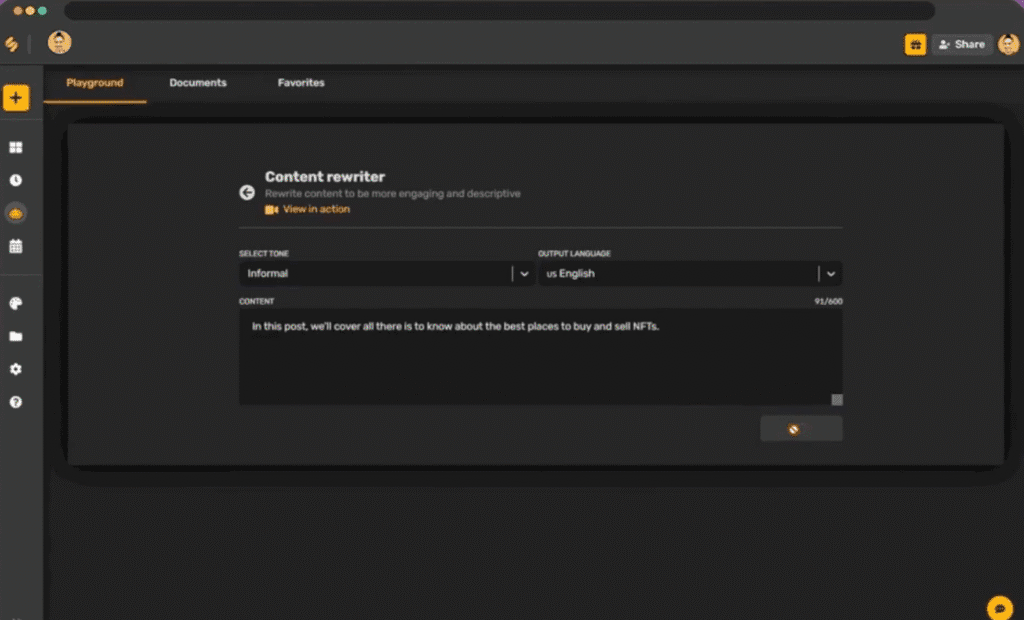
Key Features:
- AI Script Generator: Quickly create scripts tailored to short-form video formats, with options to customize tone, style, and length.
- Multi-Language & Tone Flexibility: Supports 30+ languages and lets you choose voices like formal, casual, or energetic.
- Complete Creative Suite: More than scripts and videos: you’ll also get AI design, presentations, thumbnails, social quotes, brand kits, etc.
- Script-to-Video Workflow: You can convert your text into videos directly, using built-in narration, automated captions, visuals, templates, and team collaboration features.
- User-Friendly: Celebrated for its clean design, intuitive navigation, and seamless collaboration.
Cons:
- Feature Overlap Can Overwhelm: With so many tools in one place, there’s a learning curve if you’re not used to a multitool platform.
- Script Depth Can Be Limited: Great for social and short-form, but longer, cinematic storytelling may need external tools or refinement.
Review: Simplified is powerful for social-first creators, marketers, and small teams who thrive on convenience and speed. If you’re focused on cinematic narratives or deep storytelling, you might still pair it with a more dedicated screenplay tool.
AI script generators in 2025 aren’t just convenient, they’re becoming essential creative partners. At the end of the day, the “best” tool depends on your needs: whether you’re writing ad scripts, storyboarding YouTube content, or producing a corporate training video. Explore, test, and see which platform aligns with your creative goals.
Read our other AI-related blogs here:
- Best AI Transcription Tools in 2025
- Top AI Companies in Singapore in 2025
- Top Underused ChatGPT Features That You Need to Use in 2025
FAQs
Most AI script generator allows you to adjust tone, but the depth of the customization differs. Some are better for quick and preset options, some usually generate more polished, longer-form scripts, and others focus on short-form efficiency. As for plagiarism, most tools produce original content, but users should still run outputs through plagiarism checkers to avoid overlap with existing text.
AI tools can occasionally generate generic, biased, or repetitive content. Over-reliance may lead to scripts that lack human creativity and nuance. Nearly all tools require a final human edit to refine tone, ensure factual accuracy, and align with brand messaging.
Beginner-friendly platforms include Rytr, Simplified, and Copy.ai, thanks to their straightforward interfaces and pre-designed templates. Professionals often prefer Jasper, Writesonic, and Squibler for their advanced customization and scalability.
AI scriptwriting is moving toward multimodal capabilities, where text, voice, and video blend seamlessly. The future will likely bring hyper-personalized scripts, deeper integrations with creative suites, and more emphasis on ethical AI use.
Disclosure – This post contains some sponsored links and some affiliate links, and we may earn a commission when you click on the links at no additional cost to you.

